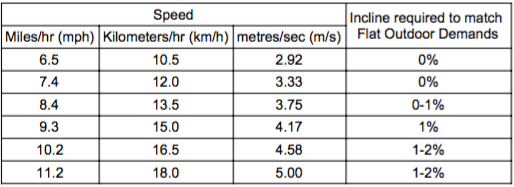In Autumn and Winter many runners begin swapping their usual outdoor run for the warmth of their local gym. But is the treadmill a good alternative to your local park? We’re often asked by patients, keen runners and inquisitive gym-goers about the effectiveness of a treadmill workout, and if they are at risk of any injuries when using them. Here are our top 3 questions.
No – it can actually improve impact forces by altering your stride pattern
There are lots of research articles looking at kinetics, joint mechanics and joint loading while on a treadmill compared to normal running pattern. A study by Riley et al (2008) used slow-motion camera equipment to track the limb movement of runners at their normal pace both on a treadmill and overground running. When on the treadmill, the researchers found significant increases in stride cadence (steps per minute), shortening of stride length, and a shorter stride duration for all participants.
A shorter stride length and increased cadence, has been shown to reduce the impact force to the ankles and knees, and better disperse the impact across the joints; this reduces the stress on the anterior portion of the knees, particularly the patella-femoral joint (a common source of pain in runners).
Not significantly, as long as you don’t hold on to the treadmill!
The same research by Riley et al (2008) confirmed previous research that showed that the power exerted by hip, knee and ankle muscles was slightly altered while on the treadmill, but not significantly.
All force readings around the leg were within 1 standard deviation of the overground running group, which showed the mechanics were quite similar on both surfaces. This was consistent through all participants, as long as the individual did not use their arms. However as soon as the participant held onto the front or side handles, their technique deteriorated significantly though.
It depends entirely on the speed of your workout: Sprint Training? Crank up the incline. An average 5km run? Probably not necessary.
This is one of the most common misinterpreted rules individuals stick to, choosing a 1-2% incline for all manner of reasons (e.g. reducing impact on knees, replicating outdoor terrain, improving running style, etc.). However none of these claims have been confirmed through scientific research, apart from one – matching the same intensity of outdoor running over certain speeds for more than 10 minutes.
Research looking at physical demands on the body shows that running indoors on a level treadmill at 13.5km/h or above doesn’t meet the same aerobic requirements on the body compared to the same pace on outdoor level surfaces (Jones and Doust, 1996). This means that it is easier for you to sprint at 14km/h on a treadmill than it is to sprint at 14km/h outside. The difference in indoor vs outdoor demands is often attributed to the lack of air resistance when running in a static position (treadmill) rather than travelling over ground.
The results of this study showed that running at any speed below 14km/h does not have a significant impact on how challenging the run is when comparing running surface at any incline. Therefore, if you take longer than 7 mins to cover one mile, you aren’t cheating yourself out of a workout by keeping the treadmill flat.
Below is a handy table to see what incline you should use to match your flat outdoor running demands:

In conclusion, Treadmills are not any more detrimental to our bones or joints than your usual running surface. They don’t cause you to run any differently than over ground (as long as your arms are swinging). And unless you’re running faster than 15km/h, treadmills are pretty accurate at emulating the cardiovascular demands of your usual run without an incline.
Riley et al (2008) A Kinematic and Kinetic comparison of overground and treadmill running; Med Sci Sport Exerc 40(6); p.1093-10.
Schubert et al (2013) Influence of stride frequency and length on running mechanics: A systematic review; Sports Health 6(3); p.210-7.
Jones AM, Doust JH (1996) A 1% treadmill grade most accurately reflects the energetic cost of outdoor running; J Sports Sci 14(4); p.321-7.